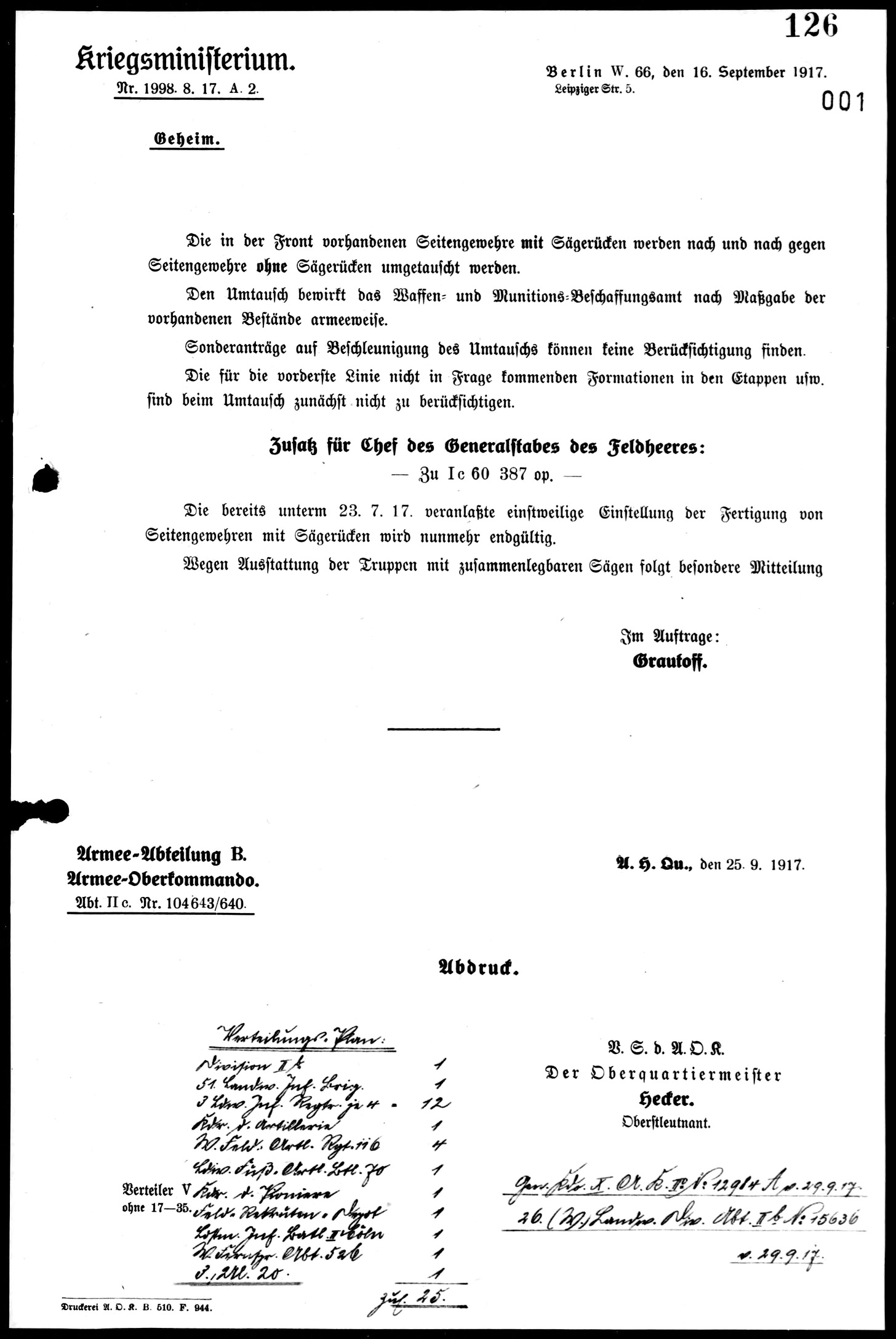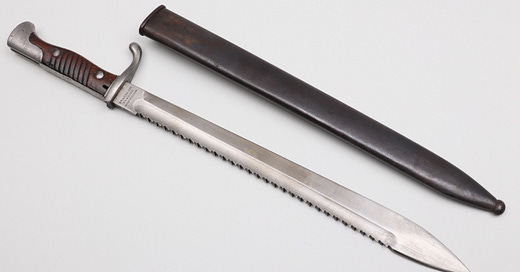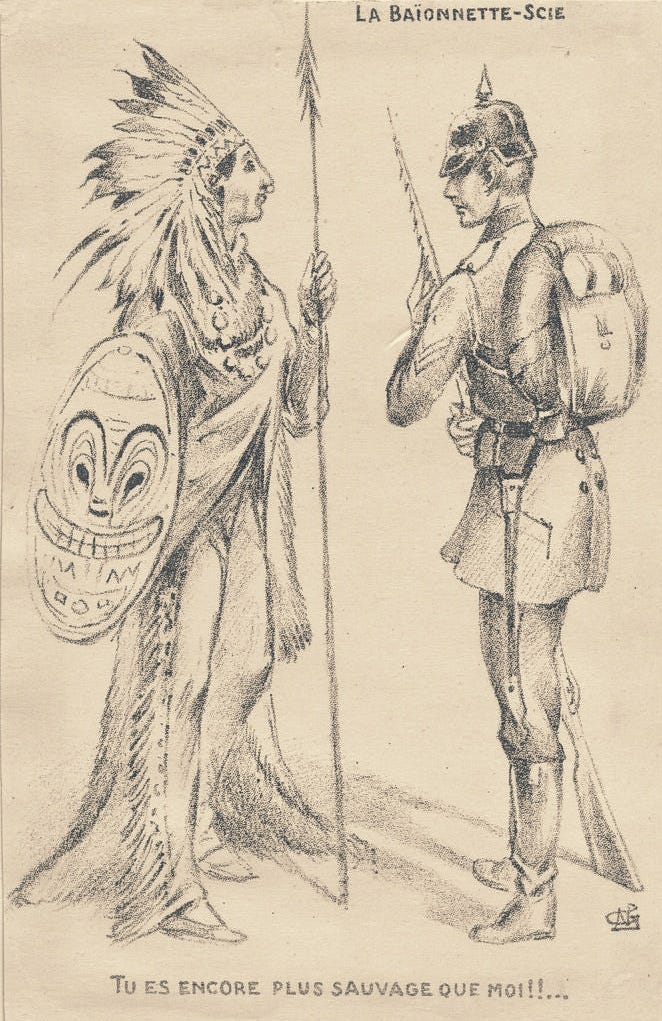'A LOT OF PIFFLE': THE GERMAN SAWBACK BAYONET
The German Sawback Bayonet of the First World War: Myth and Reality
A LOT OF PIFFLE: MYTH OF THE GERMAN SAWBACK BAYONET IN THE FIRST WORLD WAR.
by Robin Schäfer
‘They will soon have done everything, these Germans, to be banished from humanity, and it will soon be clear to everyone that their armies are nothing but hordes of barbarians, vile herds of wild beasts..’
No other hand-held weapon of the First World War has sparked so much debate and gave rise to so many myths and legends than the German Sägerücken or sawback bayonet. Even today the collectors market, historians and even the press still spread those myths that were born 115 years ago by the Allied press. In this article we will take a new and fresh look on the iconic weapon, its history and the wave of propaganda it caused in 1914.
SÄGERÜCKEN - THE SAWBACK BAYONET
The first ‘German’ sword bayonet which could be affixed to a long arm was introduced in Prussia in 1810. Used by the kingdom’s elite, light Jäger (hunter) infantry it was designated as a Hirschfänger (lit: ‘stag catcher’, or hunting knife). It would take another 50 years until the introduction of what could be called the first modern sword bayonet for regular infantry units, the M1860 Füsilier-Seitengewehr. With the introduction of the Mauser M71 bolt action rifle and its matching bayonet in the German Army, the first sawback or Sägerücken bayonets were introduced en masse to replace the Faschinenmesser, the fascine knife. This edged weapon, with a serrated or straight edge, was an engineering and foraging tool designed to cut forage and firewood, to remove foliage, and - thus the name - to cut “fascines”, brushwood bundles bundles used for strengthening earthen structures and field fortifications or for making a path across uneven or wet terrain.
At the outbreak of the First World War the German Army moved into the field with a wide range of bayonet types, all of which were available in a saw-backed version. They were issued to Pionier (engineer) units and, in a small percentage, distributed among other army line units. Then they were still being used as tools to cut wood and to efficiently saw through wooden barbed wire stakes, which were later replaced by metal ones. In that role they could be used as a handheld, but also as a rifle-mounted saw. Used in the latter way it was much more efficient, allowing it to cut through a thick, wooden barbed wire pole in about 30 seconds (using the long M98 saw-bayonet). Many other nations had made use of bayonets of a similar kind, including the British (with the Elcho and P1879 Martini-Henry sword bayonets) and the Swiss in 1878, all of these weapons designed to replace the fascine knives carried by soldiers in earlier periods.
At the turn of the century, military logistics and supply for forces in the field had evolved so far that the need for foraging tools had diminished. Saw backed bayonets were inferior in combat as the serrated edge could get caught or entangled in clothing, while the sharp saw itself could easily cause wounds to an inexperienced user. When war broke out in 1914 they had been made redundant in the British Army. The German Army, with its doctrine of flexibility in the field, had retained them and still saw them as an important addition to its forces.
A SAVAGE WEAPON?
The sawback bayonet was a gift to the Allies, who from a very early date set their propaganda machine to work, tying the use of the weapon into the context of the so-called ‘rape of Belgium’ , feeding the notion that the barbaric weapon had been specifically developed as brutal refinement for use in close combat. Sawback bayonets it was suggested, inflicted painful, never-healing wounds and even worse, as a French propaganda booklet with the title of ‘Les armes déloyales des allemands’ (the unfair weapons of the Germans) explained in 1916:
“In some German infantry units and throughout the pioneer corps, some men are armed with a bayonet sword, with a flat and wide blade, one edge is sharp while the other is sawtoothed. Officially it is a portable tool, intended to act in the twin role of saw and sword of battle, according to the way it is used. In reality, it is a very dangerous weapon, which, when held at the end of the rifle, inflicts a wound much more serious than that caused by ordinary bayonets in that it produces tearing effects when a soldier pulls to remove it from the body of an enemy. But German officers know how to refine barbarity. There is a standing order to all men armed with the bayonet-saw never to attack without having taken the precaution of repeatedly driving the blade in the loose soil, so that the particles of earth clinging to the saw will lead to an infection of the wounds inflicted on the enemy. This thoughtful and scientific cruelty is sometimes perfected even further. During an attack in Artois, a German company was taken under the fire of our machine guns and completely destroyed: ours having progressed and conquered the ground, had the obligation to bury the enemy dead and it was then possible to note that all the saw bayonets of the massacred men were coated with faeces. It demands no further explanation what horrendous complications of sepsis and infection wounds caused by a weapon like this would lead to.”
First brief mentions of German ‘bayonets with teeth’ can be found in the British Daily Mail and a number of US newspapers between 20-22 August 1914. Yet the first dedicated, longer piece on the sawback bayonet was published - to the author’s best knowledge - by the French Le Matin newspaper on 13 September 1914. It featured a photo of the serrated blade of a German M98 bayonet and a report, which seems to have formed the basis of virtually all later French and British reports and the root of the propaganda hype that followed:
‘They will soon have done everything, these Germans, to be banished from humanity, and it will soon be clear to everyone that their armies are nothing but hordes of barbarians, vile herds of wild beasts. Today you can see with this kind of weapon they intend to prevail over their enemies. Here is the photograph of a sword bayonet collected yesterday among the dead of the 47th regiment of Prussian infantry in Varreddes, a small village located about 8 kilometers north of the city of Meaux. This bayonet has two lines of sawtooth on its back. And it is not the cruel fantasy of a single, barbarian soldier who has created this weapon worthy of a Malay for his own use; no, because many others lay scattered on the ground and some have been picked up by officials to be shown to the public. It is clear that they have been machine-made and that this cruelty has an official origin. A torture device; a bayonet with hooks; a dishonourable weapon: a violation which S.M. Emperor William had provided his soldiers with.’
Even though Infanterie-Regiment Nr. 47 had never been in action anywhere near Varreddes (serving around Les Eparges about 250 kilometres away), some sawback bayonets had certainly been found, after all the whole of the German Army was equipped with them. The news travelled quickly and seems to have crossed the Atlantic first, even before reaching the United Kingdom. The New York Tribune ran it as front page news on 19 September. Their correspondent Richard Harding Davis, attached to the French Army, gave a detailed testimony about what had been found. a bayonet which ‘tears the flesh and splinters the bone’ and ‘the most gruesome weapon of war ever issued to a civilised army’.
From the United States the news travelled. and from the second half of September up to November 1914 the British press covered the subject extensively, often using new eyewitness accounts and photographs. On 27 September .The People newspaper published a photograph of a British medical officer comparing a British P07 Enfield bayonet to a German 98/05 sawback, reporting that these weapons were used ‘in violation of the laws of war’ and in breach to the ‘Convention to which Germany is a signatory’.
While the press coverage spread out, postcards were published in France showing a German soldier - with a sawback bayonet attached to his rifle - being addressed by a member of what people at the time would have seen as a savage race, a native American warrior. The postcards were captioned ‘La Baïonnette Scie’ and bore the slogan ‘Tu es encore plus sauvage que moi!’ (You are even more savage than me). French depictions of German sawback bayonets turned things upside down completely, showing the blade (!) of the bayonet sporting a serrated edge.
Surprisingly, some publications both in England and in France, also published truthful features about the actual use of the weapon. The Illustrated War News of 18 November printed a large format photo of a German soldier holding a rifle with a saw-tooth bayonet which rightly claimed that the bayonet was similar to that carried by ‘British naval landing parties for use in sawing wood’; while the French journal L'Ouest-Éclair stated that the ‘bayonet-saw is used to saw the wood in the countryside to make fires and employed in a variety of manual attack or defence work.’
‘(…) when a man has eight inches of smooth blade in him, an inch or two of jagged teeth would not matter’.
Some newspapers published reader’s letters on the bayonet. Doctor Hirsch, a native German, then working a psychiatrist in New York, wrote to the Tribune that he himself had served in the German Army in 1878/79 and that the whole story like ‘so many other statements about the -brutality- of the German Army are based on utter ignorance of the real facts’. He described the weapon’s use as a pioneer tool while criticising the paper’s malevolent coverage. In fact, some the best and most neutral words about the case, were published in the form of reader’s letters. One, written in Mounie Castle, Oldmeldrum by a Major Seton and published by The Aberdeen Daily Journal stated that: ‘Regarding the tooth-edged bayonet, about which you quote from the Paris ‘Matin’ as being among the atrocities of the Kaiser and his ‘Huns’, may I say that such allegations are merely the ravings of an hysterical Frenchman?’. Another, sent to the Liverpool Daily Post and Mercury opened with the statement that ‘A lot of piffle has been written about the German saw-bayonet’ and closed with the observation that ‘when a man has eight inches of smooth blade in him an inch or two of jagged teeth would not matter’. By mid-1915 there are no mentions of the saw-bayonet anymore. The explosive value of the story had fizzled out.
Yet the damage had been done and the propaganda was beginning to have a noteworthy effect on the Germans. Even though never based on any actual truth, rumours had begun to circulate that the Allies would shoot or torture prisoners carrying a saw-bayonet. Even though there have never been any documented cases of this behaviour and even an official German inquest in July 1915 and another in April 1917 could not find any evidence of this, it became an often told story in the army. Ernst Jünger mentioned it and Erich Maria Remarque used it in his famous anti-war novel All Quiet on the Western Front: ‘We overhaul the bayonets--that is to say, the ones that have a saw on the blunt edge. If the fellows over there catch a man with one of those he's killed at sight. In the next sector some of our men were found whose noses were cut off and their eyes poked out with their own saw-bayonets. Their mouths and noses were stuffed with sawdust so that they suffocated’.

REMOVING THE SAW
German soldiers soon began to ‘lose’ their sawback bayonets in inexplainable numbers, while others began to remove the saw backs on their own accord, thus often permanently damaging the blade and as such property of the German Empire. By 1917, with the large-scale use of metal barbed wire pickets, the bayonet-saw had lost its only real remaining use and German soldiers had realised, that the saw could slow retrieval of the blade in combat. The wounds a sawback bayonet caused were not worse that those created by regular blade, and as such the use of them had never violated any rules of war, yet faced with the mass loss of good bayonets and knowing about the weapon’s deficiencies. the OHL (Oberste Heeresleitung, Supreme Army Command) issued an order on 16 September 1917. which decreed that all sawback bayonets were to be withdrawn from service in frontline formations, to be replaced by regular bayonets. To satisfy the need for a sawing tool the so called Noris-Säge, a segmented and much more effective saw, was issued. Formations serving in rearward areas, garrison and replacement units and formations serving within the borders of the Reich continued carrying the sawback. Surplus was put into storage. Yet in a war of materiel and in the face of serious metal shortages, having a large stock of unusable bayonets was something Germany could not afford. Trials had shown that bayonets with ground-away saws could be used without disadvantage, so on 6 January 1918 order was given to grind away the saws. The bayonets treated in that manner were designated “S.Abg.” (Säge abgeschliffen - saw removed) and were again issued to frontline units. Yet this was only done with a fraction of the available weapons and most of that work was done when stock was used to equip the new Reichswehr from 1920.
THE PRESENT DAY: THE ‘PIFFLE’ CONTINUES
Even today a ‘lot of piffle’ is still being spread about the savage nature of the sawback bayonet in books and other publications, and that is probably the reason why prices collectors are willing to pay for the acquisition of a nice Sägerücken continue to soar. However, they are not as rare as militaria collector’s and dealers wants us to believe. Most saws were never ground out, and today a bayonet with the saw removed is a lot more difficult to find than one with a surviving saw. Yet the fascination radiating from a shiny, saw-toothed back of a German 98/05 bayonet and the piffle attached to them is certainly real. As such they rightfully continue to hold special places in bayonet collections all over the world.









Great article, Rob. Great history, in bite size chunks!
I am lucky to have both a 98/05 Sägerücken and a Säge abgeschliffen version. In my small collection of WW1 German military equipment.